3.1 Git Branching
来源:互联网 发布:java 两个类互相引用 编辑:程序博客网 时间:2024/06/07 14:44
Nearly every VCS has some form of branching support.Branching means you diverge from the main line of development and continue to do work without messing with that main line.In many VCS tools, this is a somewhat expensive process, often requiring you to create a new copy of your source code directory, which can take a long time for large projects.
Some people refer to Git’s branching model as its “killer feature,” and it certainly sets Git apart in the VCS community.Why is it so special?The way Git branches is incredibly lightweight, making branching operations nearly instantaneous, and switching back and forth between branches generally just as fast.Unlike many other VCSs, Git encourages workflows that branch and merge often, even multiple times in a day.Understanding and mastering this feature gives you a powerful and unique tool and can entirely change the way that you develop.
Branches in a Nutshell
To really understand the way Git does branching, we need to take a step back and examine how Git stores its data.
As you may remember from Getting Started, Git doesn’t store data as a series of changesets or differences, but instead as a series of snapshots.
When you make a commit, Git stores a commit object that contains a pointer to the snapshot of the content you staged.This object also contains the author’s name and email, the message that you typed, and pointers to the commit or commits that directly came before this commit (its parent or parents): zero parents for the initial commit, one parent for a normal commit, and multiple parents for a commit that results from a merge of two or more branches.
To visualize this, let’s assume that you have a directory containing three files, and you stage them all and commit.Staging the files computes a checksum for each one (the SHA-1 hash we mentioned inGetting Started), stores that version of the file in the Git repository (Git refers to them as blobs), and adds that checksum to the staging area:
$ git add README test.rb LICENSE$ git commit -m 'The initial commit of my project'When you create the commit by running git commit, Git checksums each subdirectory (in this case, just the root project directory) and stores those tree objects in the Git repository.Git then creates a commit object that has the metadata and a pointer to the root project tree so it can re-create that snapshot when needed.
Your Git repository now contains five objects: one blob for the contents of each of your three files, one tree that lists the contents of the directory and specifies which file names are stored as which blobs, and one commit with the pointer to that root tree and all the commit metadata.
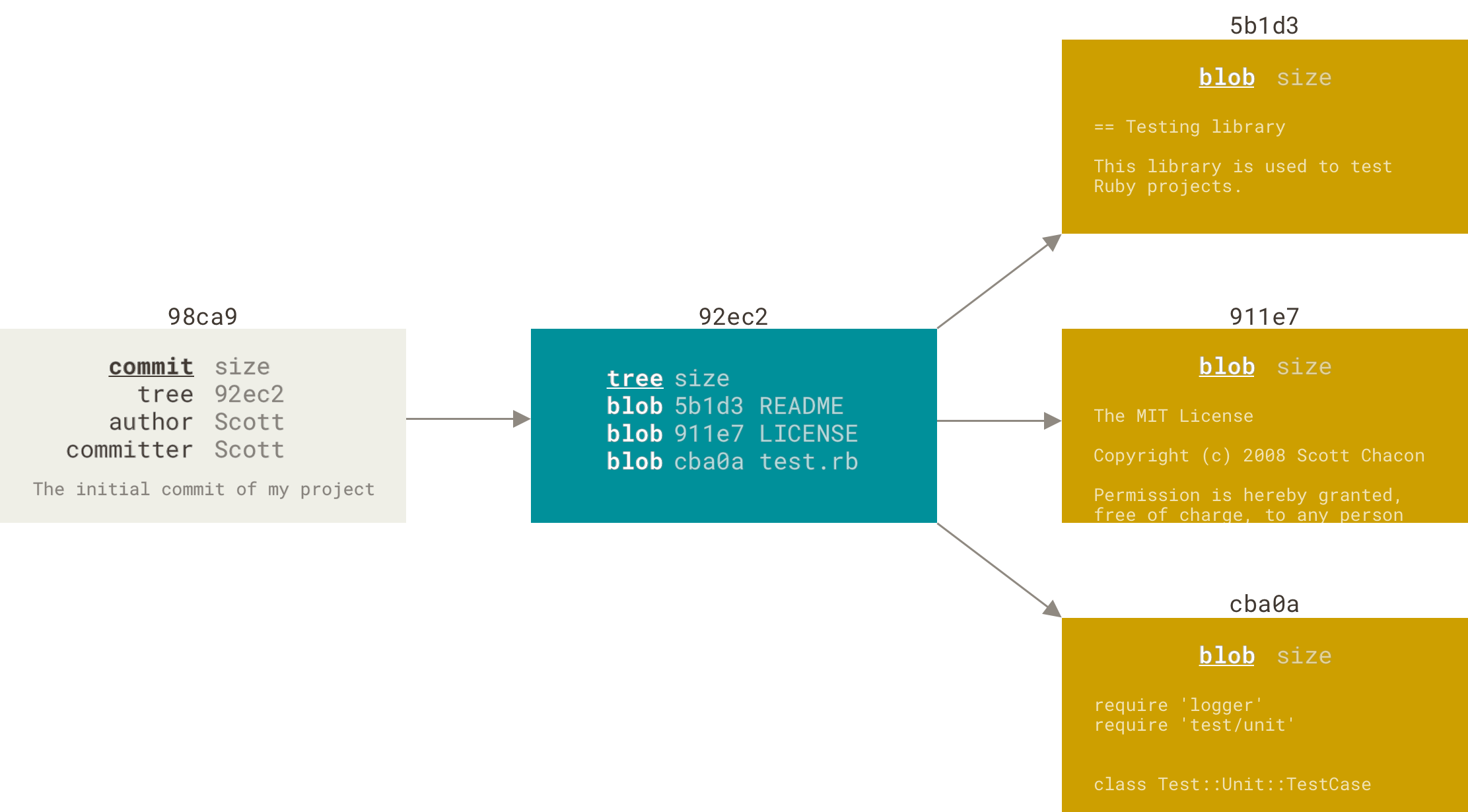
If you make some changes and commit again, the next commit stores a pointer to the commit that came immediately before it.

A branch in Git is simply a lightweight movable pointer to one of these commits.The default branch name in Git ismaster.As you start making commits, you’re given a master branch that points to the last commit you made.Every time you commit, it moves forward automatically.
The “master” branch in Git is not a special branch.It is exactly like any other branch.The only reason nearly every repository has one is that thegit init command creates it by default and most people don’t bother to change it.
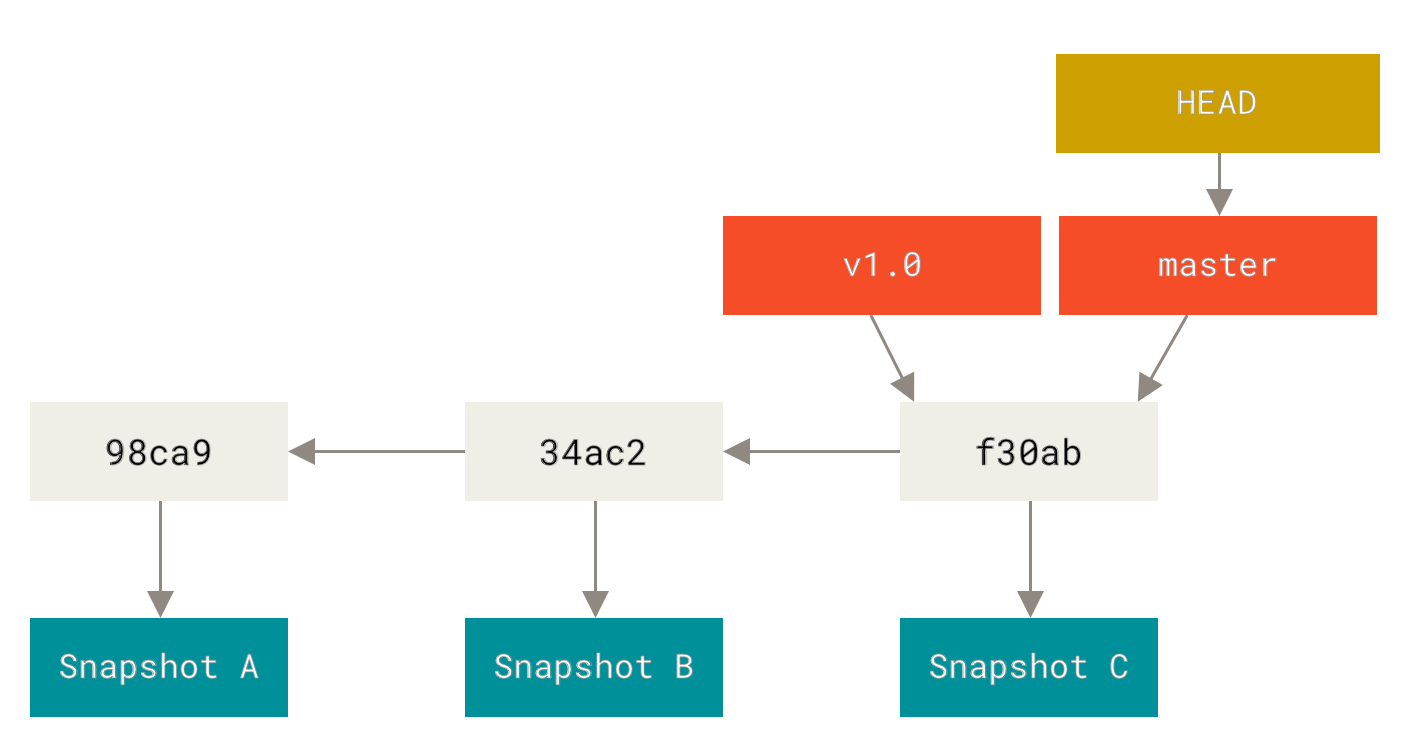
Creating a New Branch
What happens if you create a new branch?Well, doing so creates a new pointer for you to move around.Let’s say you create a new branch called testing.You do this with thegit branch command:
$ git branch testingThis creates a new pointer to the same commit you’re currently on.
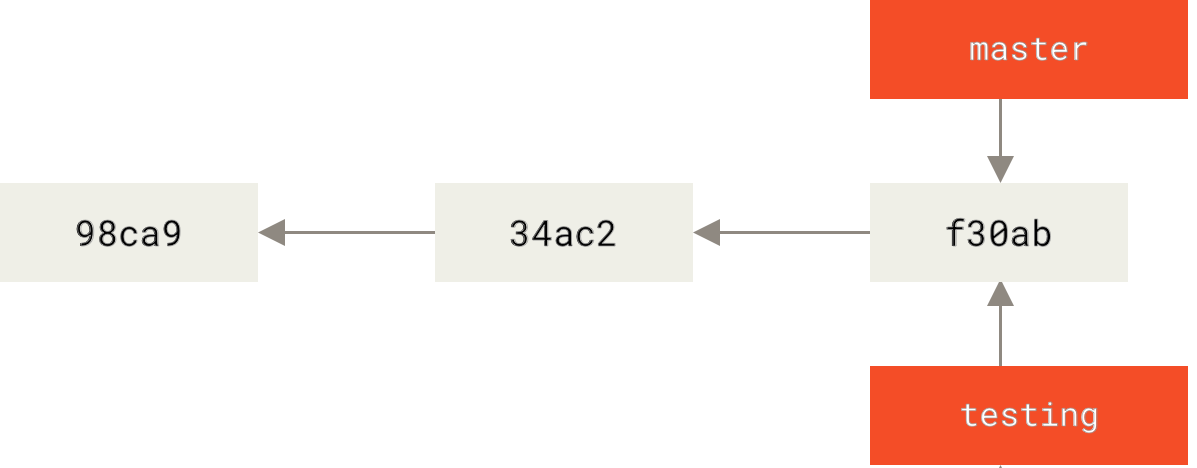
How does Git know what branch you’re currently on?It keeps a special pointer calledHEAD.Note that this is a lot different than the concept of HEAD in other VCSs you may be used to, such as Subversion or CVS.In Git, this is a pointer to the local branch you’re currently on.In this case, you’re still onmaster.The git branch command only created a new branch – it didn’t switch to that branch.
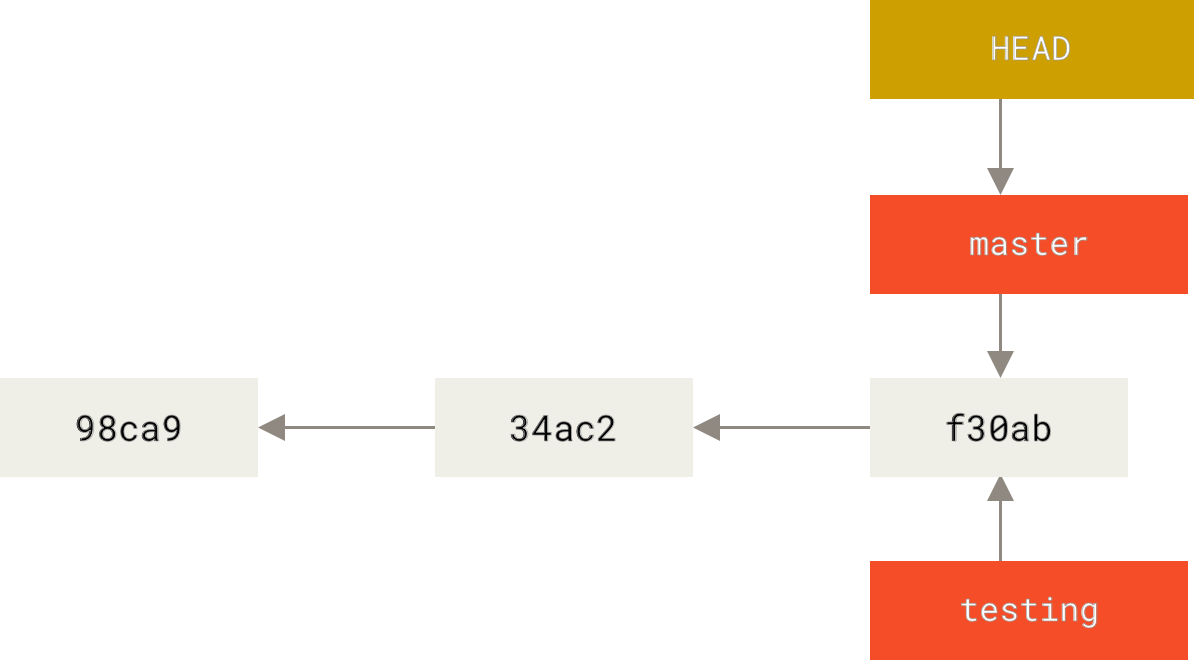
You can easily see this by running a simple git log command that shows you where the branch pointers are pointing.This option is called--decorate.
$ git log --oneline --decoratef30ab (HEAD -> master, testing) add feature #32 - ability to add new formats to the central interface34ac2 Fixed bug #1328 - stack overflow under certain conditions98ca9 The initial commit of my projectYou can see the “master” and “testing” branches that are right there next to thef30ab commit.
Switching Branches
To switch to an existing branch, you run the git checkout command.Let’s switch to the newtesting branch:
$ git checkout testingThis moves HEAD to point to the testing branch.
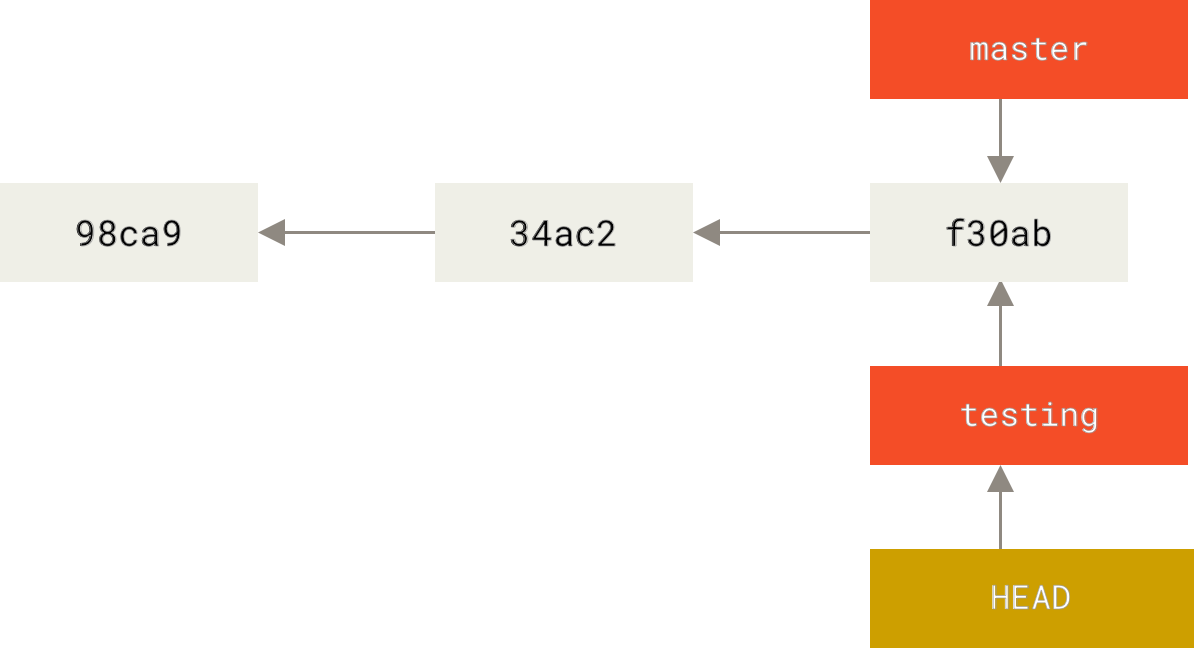
What is the significance of that?Well, let’s do another commit:
$ vim test.rb$ git commit -a -m 'made a change'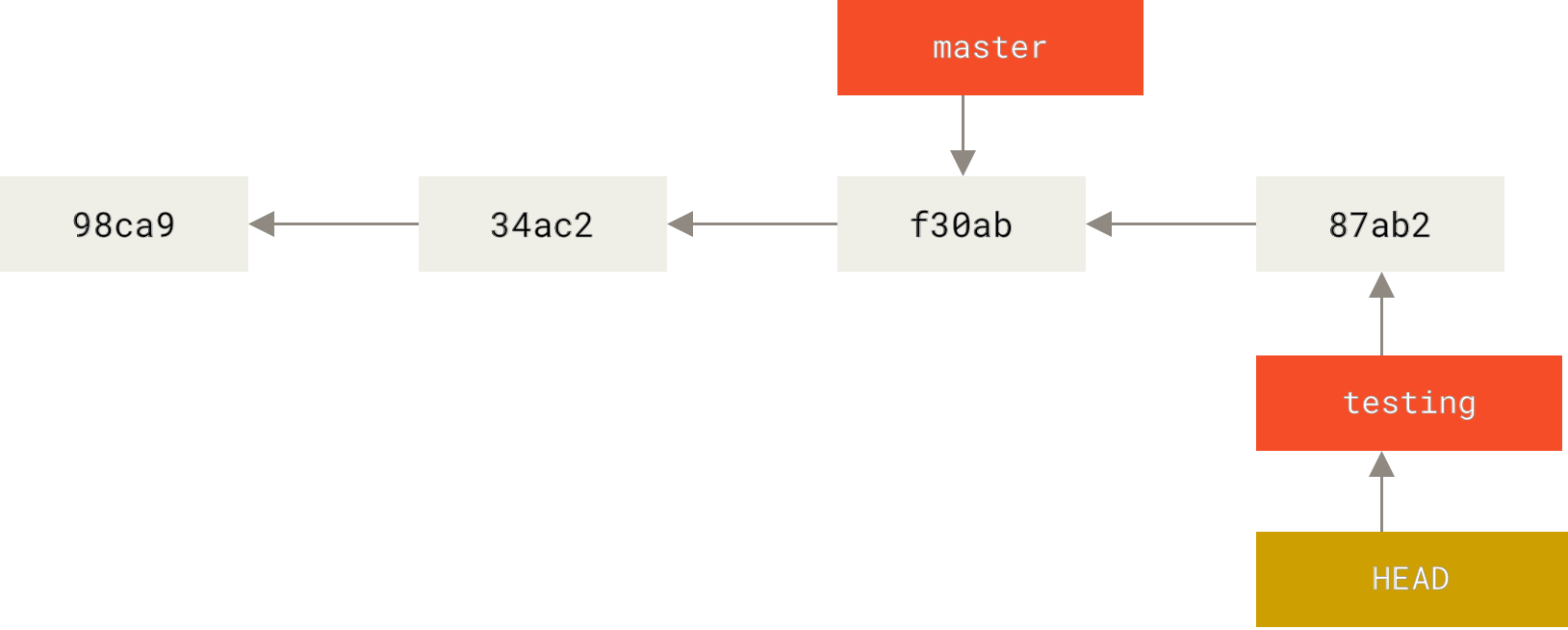
This is interesting, because now your testing branch has moved forward, but yourmaster branch still points to the commit you were on when you ran git checkout to switch branches.Let’s switch back to the master branch:
$ git checkout master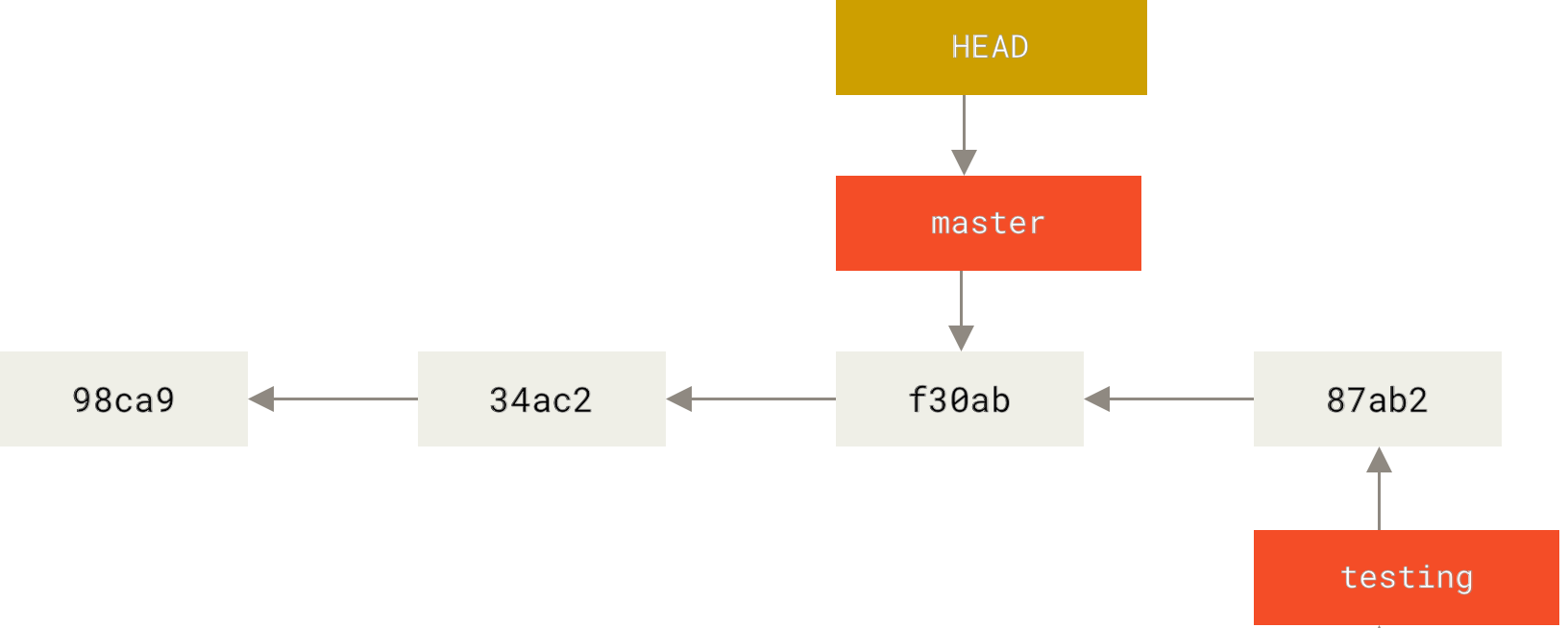
That command did two things.It moved the HEAD pointer back to point to the master branch, and it reverted the files in your working directory back to the snapshot thatmaster points to.This also means the changes you make from this point forward will diverge from an older version of the project.It essentially rewinds the work you’ve done in yourtesting branch so you can go in a different direction.
It’s important to note that when you switch branches in Git, files in your working directory will change.If you switch to an older branch, your working directory will be reverted to look like it did the last time you committed on that branch.If Git cannot do it cleanly, it will not let you switch at all.
Let’s make a few changes and commit again:
$ vim test.rb$ git commit -a -m 'made other changes'Now your project history has diverged (see Divergent history).You created and switched to a branch, did some work on it, and then switched back to your main branch and did other work.Both of those changes are isolated in separate branches: you can switch back and forth between the branches and merge them together when you’re ready.And you did all that with simple branch,checkout, and commit commands.
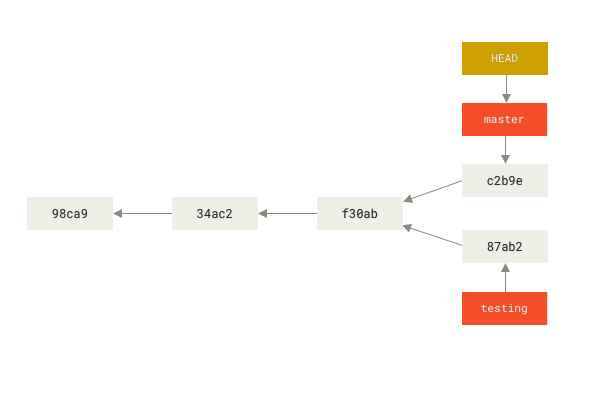
You can also see this easily with the git log command.If you run git log --oneline --decorate --graph --all it will print out the history of your commits, showing where your branch pointers are and how your history has diverged.
$ git log --oneline --decorate --graph --all* c2b9e (HEAD, master) made other changes| * 87ab2 (testing) made a change|/* f30ab add feature #32 - ability to add new formats to the* 34ac2 fixed bug #1328 - stack overflow under certain conditions* 98ca9 initial commit of my projectBecause a branch in Git is actually a simple file that contains the 40 character SHA-1 checksum of the commit it points to, branches are cheap to create and destroy.Creating a new branch is as quick and simple as writing 41 bytes to a file (40 characters and a newline).
This is in sharp contrast to the way most older VCS tools branch, which involves copying all of the project’s files into a second directory.This can take several seconds or even minutes, depending on the size of the project, whereas in Git the process is always instantaneous.Also, because we’re recording the parents when we commit, finding a proper merge base for merging is automatically done for us and is generally very easy to do.These features help encourage developers to create and use branches often.
Let’s see why you should do so.
- 3.1 Git Branching
- 3.2 Git Branching
- 3.3 Git Branching
- 3.4 Git Branching
- Git学习笔记-Git Branching
- A successful Git branching model
- A successful Git branching model
- A successful Git branching model
- A successful Git branching model
- A successful Git branching model
- A successful Git branching model
- A successful Git branching model
- A successful Git branching model
- Git Reference---Branching and Merging
- A successful Git branching model
- A successful Git branching model
- A successful Git branching model
- Git Reference---Branching and Merging(2)
- 九度OJ-题目1168:字符串的查找删除-string的使用(转)
- 【OpenCV入门教程之一】 安装OpenCV:OpenCV 3.0、OpenCV 2.4.8、OpenCV 2.4.9 +VS 开发环境配置
- 音频重采样
- android 通过uri获取bitmap图片并压缩
- 点击图片,图片src重新加载(用于图片验证码)
- 3.1 Git Branching
- 各种有趣的 ARKit 展示:金发美女乱跳、怪兽来袭等
- 图片本身加上圆角
- java缓存技术的介绍
- CAsyncSocket
- 模板引擎doT.js介绍及如何判断对象为空、如何嵌套循环···
- td中通过button绑定click事件实现跳转,以及获取同一table中另一td的值
- android_Before Android 4.1, method android.graphics.PorterDuffColorFilter android.support.graphics.d
- 控制反转 IOC (Inversion of Control)


